![]()
![]()
![]()
Use LEFT and RIGHT arrow keys to navigate between flashcards;
Use UP and DOWN arrow keys to flip the card;
H to show hint;
A reads text to speech;
5 Cards in this Set
- Front
- Back
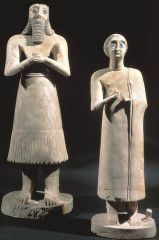
|
Statuettes of worshippers Sumerian (Style/Culture), Eshunna, Iraq, c. 2700 BCE, limestone, shell, and gypsum * Figures are of different heights, denoting hierarchy of scale * hands are folded in gesture of prayer * huge eyes in awe, spellbound, perhaps staring at the deity * men: bare upper chest; skirt from waist down; beard flows in ripple patterns * women: dress draped over one shoulderarms and feet cut away. * figures represent mortals, placed in a temple and praying
|
|
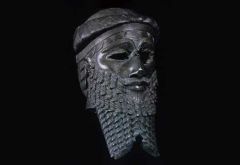
|
Head of an Akkadian king,
Akkadian (Style/Culture), ca. 2250-2200 BCE. Copper. Iraq Museum, Baghdad, Hollow-cast sculpture
Significance: casting bronze is an incredibly lengthy, time and energy consuming process. A society would need to have a huge economic surplus to be able to support it. |
|
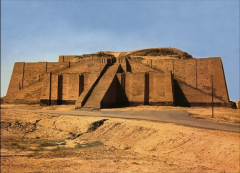
|
Ziggurat of Ur Sumerian (Style/Culture) c. 2100 BCE, Ur, Iraq * symbolized the link between heaven and earth. The stairway was possibly a stairway to heaven (from Earth). * Mud-brick Building on a colossal scale, * Entire form resembles a mountain (Sacred/Holy Mountain) * Three large staircases lead to the upper story entrance from three different directions; guardhouse at point where the staircases meet * Dedicated to the moon god Nanna |
|
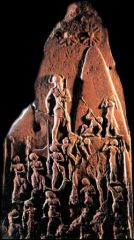
|
Victory Stele of Naram Sin
Stele = vertical slab of stone
Akkadian (Style/Culture) 2254-2218 BCE, sandstone (pink) * Naram-Sin deifies himself as the composition leads him up the mountain to the heavens, indicated by the three stars above him * Victory blessed by the gods, represented as suns, but he acts independently * King wears horned crown of divinity, bow in one hand, arrow in the other, battle axe in hollow of arm * Defeated soldiers beg for mercy, one with a lance through his throat, another thrown over the side of the mountian * Spatial isolation of king, hierarchy of scale * Figures are in composite views * Depicts his victory over the Lullubi |
|
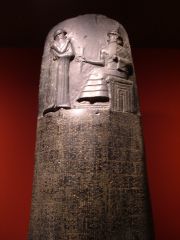
|
Stele of Hammurabi
Babylonian (Style), c. 1780 BCE, basalt * Contains one of the earliest law codes ever written * Sun god, Shamash, enthroned on a ziggurat and handing Hammurabi a rope, a ring, and a rod of kingship * Hammurabi with a speaking/greeting gesture * Shamash: frontal and profile at the same time, headress in profile; rays (wings?) from behind his shoulder * Shamash's beard is fuller than Hammurabi's * They stare at one another directly, even though their shoulders are frontal; composite views * 300 Law entries placed below the grouping, symbolically given from Shamash himself to Hammurabi |

